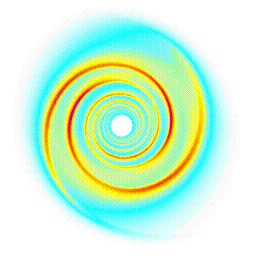- Transport Is Efficient
- In all of
our simulations, the effective alpha was at least 0.1 in the
outer regions of the accretion disk where the tidal shock waves
are excited. However, as predicted by analytic arguments, alpha
decays with decreasing radius. In cold disks such as those found
in CV systems, this drop is so precipitous that we could not measure
an alpha below a radius of only 1/3 that of the outer edge of the disk.
- Transport Is Independent of Mass Ratio.
- Varying the mass ratio from 0.2 to 5 did little to change
the spiral pattern. Moreover,
the strength of
the two-armed spiral shocks at their origin near the outer edge of
the disk was fairly constant in all of our models, independent of
mass ratio, Mach number, or density profile. This has the
consequence that, despite all else, one can be confident that the
effective alpha in the outer regions of an accretion disk in
a binary system is (at least) 0.1.

This is all good science, but the real world is three-dimensional!
We need much more computing power to do this in 3D...

